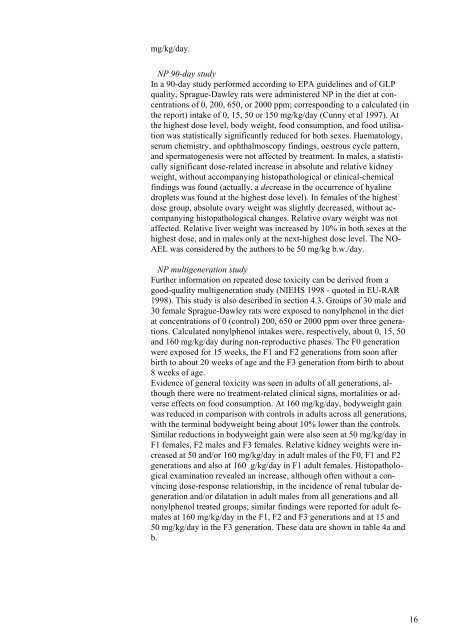Toxicological Evaluation and Limit Values for ... - Miljøstyrelsen
Toxicological Evaluation and Limit Values for ... - Miljøstyrelsen
Toxicological Evaluation and Limit Values for ... - Miljøstyrelsen
- No tags were found...
You also want an ePaper? Increase the reach of your titles
YUMPU automatically turns print PDFs into web optimized ePapers that Google loves.
mg/kg/day.NP 90-day studyIn a 90-day study per<strong>for</strong>med according to EPA guidelines <strong>and</strong> of GLPquality, Sprague-Dawley rats were administered NP in the diet at concentrationsof 0, 200, 650, or 2000 ppm; corresponding to a calculated (inthe report) intake of 0, 15, 50 or 150 mg/kg/day (Cunny et al 1997). Atthe highest dose level, body weight, food consumption, <strong>and</strong> food utilisationwas statistically significantly reduced <strong>for</strong> both sexes. Haematology,serum chemistry, <strong>and</strong> ophthalmoscopy findings, oestrous cycle pattern,<strong>and</strong> spermatogenesis were not affected by treatment. In males, a statisticallysignificant dose-related increase in absolute <strong>and</strong> relative kidneyweight, without accompanying histopathological or clinical-chemicalfindings was found (actually, a decrease in the occurrence of hyalinedroplets was found at the highest dose level). In females of the highestdose group, absolute ovary weight was slightly decreased, without accompanyinghistopathological changes. Relative ovary weight was notaffected. Relative liver weight was increased by 10% in both sexes at thehighest dose, <strong>and</strong> in males only at the next-highest dose level. The NO-AEL was considered by the authors to be 50 mg/kg b.w./day.NP multigeneration studyFurther in<strong>for</strong>mation on repeated dose toxicity can be derived from agood-quality multigeneration study (NIEHS 1998 - quoted in EU-RAR1998). This study is also described in section 4.3. Groups of 30 male <strong>and</strong>30 female Sprague-Dawley rats were exposed to nonylphenol in the dietat concentrations of 0 (control) 200, 650 or 2000 ppm over three generations.Calculated nonylphenol intakes were, respectively, about 0, 15, 50<strong>and</strong> 160 mg/kg/day during non-reproductive phases. The F0 generationwere exposed <strong>for</strong> 15 weeks, the F1 <strong>and</strong> F2 generations from soon afterbirth to about 20 weeks of age <strong>and</strong> the F3 generation from birth to about8 weeks of age.Evidence of general toxicity was seen in adults of all generations, althoughthere were no treatment-related clinical signs, mortalities or adverseeffects on food consumption. At 160 mg/kg/day, bodyweight gainwas reduced in comparison with controls in adults across all generations,with the terminal bodyweight being about 10% lower than the controls.Similar reductions in bodyweight gain were also seen at 50 mg/kg/day inF1 females, F2 males <strong>and</strong> F3 females. Relative kidney weights were increasedat 50 <strong>and</strong>/or 160 mg/kg/day in adult males of the F0, F1 <strong>and</strong> F2generations <strong>and</strong> also at 160 g/kg/day in F1 adult females. Histopathologicalexamination revealed an increase, although often without a convincingdose-response relationship, in the incidence of renal tubular degeneration<strong>and</strong>/or dilatation in adult males from all generations <strong>and</strong> allnonylphenol treated groups; similar findings were reported <strong>for</strong> adult femalesat 160 mg/kg/day in the F1, F2 <strong>and</strong> F3 generations <strong>and</strong> at 15 <strong>and</strong>50 mg/kg/day in the F3 generation. These data are shown in table 4a <strong>and</strong>b.16
















